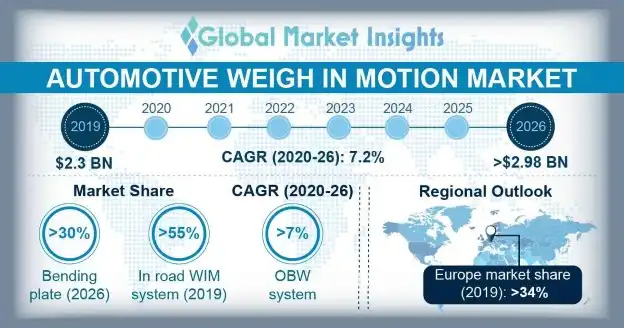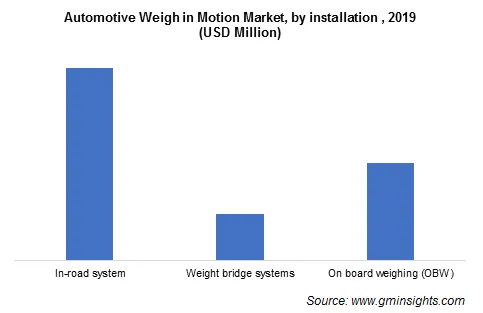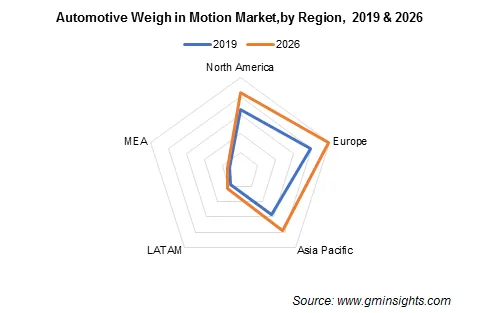


Automotive Weigh in Motion Market
Get a free sample of this report
Your inquiry has been received. Our team will reach out to you with the required details via email. To ensure that you don't miss their response, kindly remember to check your spam folder as well!
Form submitted successfully!
Error submitting form. Please try again.

Request Sectional Data
Your inquiry has been received. Our team will reach out to you with the required details via email. To ensure that you don't miss their response, kindly remember to check your spam folder as well!
Form submitted successfully!
Error submitting form. Please try again.
Automotive Weigh in Motion Market size surpassed USD 2.3 billion in 2019 and is expected to grow at a CAGR of over 7.2% between 2020 and 2026. Exceptional benefits offered by WIM systems over other conventional vehicle weighing and monitoring alternatives will augment the market growth.
Subject to adoption as well as installation of smart transportation systems across various cities throughout the globe, the automotive weigh in motion market is anticipated to achieve momentum in the coming years. China has made various headways in enhancing growth of overall transportation industry. For instance, the country has announced investment of over USD 30 billion in intelligent transport system by the end of year 2020. The aim of the project is to encourage green transport systems as well as to develop electronic transportation systems across China.

In a longer prospective, the market is expected to witness high demand across the globe. However, looking at short term scenario, amid COVID 19 impact, WIM systems demand will be on a lower side in the year 2020. As many nations are going through a nationwide lockdown, transportation industry is facing a setback, which is negatively impacting the market demand. Trucks transportation is on a higher side due to increase in goods shipment, but commercial vehicle transportation is going through rough times.
| Report Attribute | Details |
|---|---|
| Base Year: | 2019 |
| Automotive Weigh in Motion Market size in 2019: | 2.3 Billion (USD) |
| Forecast Period: | 2020 to 2026 |
| Forecast Period 2023 - 2032 CAGR: | 7.2 |
| 2023 Value Projection: | 2.98 Billion (USD) |
| Historical Data for: | 2016 to 2018 |
| No of Pages: | 142 |
| Tables, Charts & Figures: | 163 |
| Segments Covered: | Sensor, Installation Technique, Application, Speed, Region |
| Growth Drivers: |
|
| Pitfalls Challenges: |
|
Piezoelectric automotive WIM system consists of at minimum two piezoelectric sensors and one inductive loop. These are the most used sensors in WIM systems and accounted for over 40% demand share in 2019. These sensors can be of many types including piezo quartz bars, piezo ceramic bars, piezo polymer strips, etc.
As per manufactures, these sensors are classified as class 1 and class 2 based on the accuracy of sensor. Class 1 sensor are generally preferred for automotive WIM systems. However, class 2 piezo sensor are used for classification and monitor of vehicle. For improving accuracy of weigh in motion system, a minimum of four sensors are generally adviced in one weighing lane. This category of sensors is increasingly being used in the automotive industry due to the economic benefits along with durability of piezo sensors as compared to other sensors.

The in-road automotive weigh in motion sensors accounted over 55% market share in 2019. These sensors are installed in or under the road pavement to provide data of traffic loading on various locations. These systems are capable of measuring road to tire contact of vehicle with sensor installed in roads. However, this installation type requires maintenance and calibration to ensure the accuracy and data quality generated by them.
The weight enforcement is the major application segment in the automotive weigh in motion market which dominated around 40% share in 2019. Weight enforcement aims to achieve enhanced and improved compliance with loading regulations by governments across the globe. The major objective is to reduce overloading of vehicle and its negative impacts, monitoring road infrastructure wear and tear as well as to provide enhanced safety.
Automotive WIM systems offer multiple applications which help in a more efficient and effective weight enforcement throughout the globe. Growing strict government regulations regarding traffic safety and vehicle overloading is predicted to fuel the segment growth.
Low speed WIM system is a technology where weighing of vehicles takes place in a specific controlled area. This generally takes place outside the major traffic lane on a smooth and flat platform which is longer than 30 meters. There exist many countries where low speed WIM is legally allowed for trade and direct enforcement. Low speed WIM systems are majorly used in tolling and payment applications.

Europe automotive weigh in motion market holds over 34% revenue share as countries like Slovenia, Netherlands, Switzerland, and UK have installed WIM sites. Moreover, due to strict government regulations regarding traffic safety and vehicle overloading, the demand for weigh in motion systems is on a higher side in the region. For instance, on board weighing system is also an option introduced to member states as per directive 96/33/EC for controlling vehicle overloading in these states. Also, with growing vehicle sales and traffic congestion in many European countries, the WIM technology is also expected to flourish in near future.
Major industry players engaged in manufacturing of weigh in motion systems are
As WIM technology is still in its emerging phase in many regions. Several players engaged in the manufacturing of WIM systems are adopting various strategies to improve their product growth. For instance, in the year 2018, Kistler launched advanced WIM systems which helps in assisting traffic monitoring, weight enforcement and weight-based trolling. Innovation and new product launches to increase industry growth.
Market by Sensor
Market by Installation Techniques
Market by Application
Market by Speed
The above information is provided on a regional and country basis for the following:
The industry share of automotive weigh in motion is expected to grow at a CAGR of over 7.2% between 2020 and 2026
Major industry players include Kistler, Q Free, TE Connectivity, EFKON, and International Road Dynamics.
According to the analysts at GMI, the in-road system installation segment dominated around 55% industry share in 2019.
The weight enforcement is the major application segment in the market which dominated around 40% share in 2019, says Global Market Insights, Inc.
The market size of automotive weigh in motion was surpassed USD 2.3 billion in 2019.
Europe market holds over 34% market revenue share as countries like Slovenia, Netherlands, Switzerland, and UK have installed WIM sites.